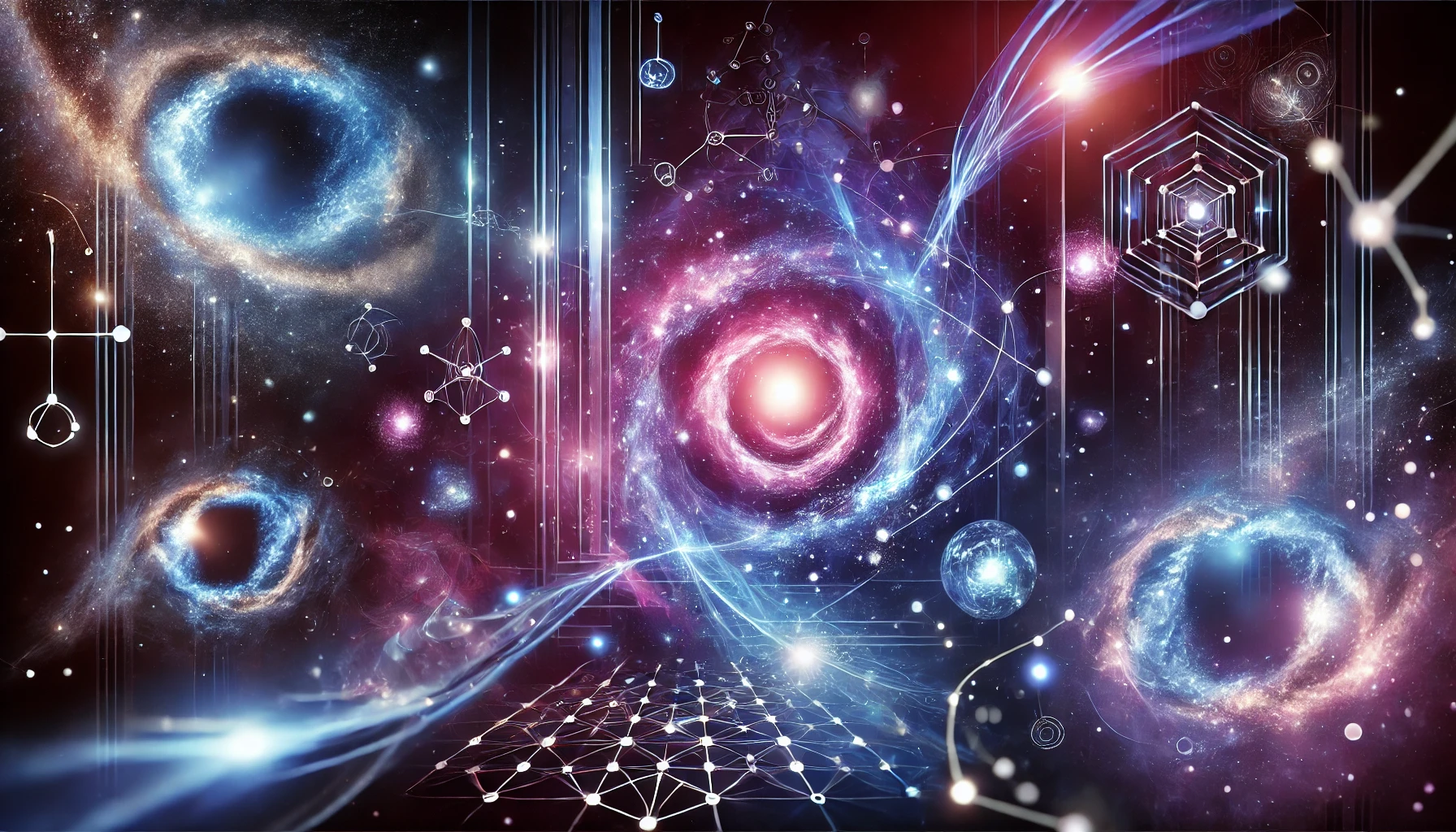The idea of a multiverse—a collection of multiple universes existing simultaneously—has captured the imagination of scientists, philosophers, and the public alike. While the concept may sound like science fiction, it has gained traction in the scientific community through various interpretations that seek to explain the underlying nature of reality. From quantum mechanics to cosmology, multiple theories offer different perspectives on what the multiverse could be and how it might operate. This blog will explore the leading interpretations of the multiverse, examining their scientific foundations, implications, and the challenges they face.
Table of Contents
The Inflationary Multiverse: A Cosmic Landscape
One of the most prominent theories supporting the existence of a multiverse comes from the field of cosmology, particularly through the concept of cosmic inflation. This theory suggests that the universe underwent a rapid expansion shortly after the Big Bang, leading to the possibility of multiple, separate universes.
- The Big Bang and Inflation: The inflationary theory of the universe, first proposed by physicist Alan Guth in the early 1980s, posits that a fraction of a second after the Big Bang, the universe expanded exponentially. This rapid expansion smoothed out any irregularities, giving the universe its uniform structure. However, inflation also implies that this process could occur in patches, creating separate regions of space that are disconnected from one another. Each of these regions, or “bubble universes,” could have its own set of physical laws and constants, forming a multiverse.
- Eternal Inflation: The concept of eternal inflation, introduced by physicists such as Andrei Linde, takes the idea of inflation further by suggesting that inflation never completely stops. Instead, while inflation ends in some regions, creating “pocket universes,” it continues in others. This leads to a scenario where the creation of new universes is an ongoing process, resulting in an infinite number of universes within the multiverse. Each universe may have different properties, with varying strengths of forces, particle types, and dimensions, making each bubble universe unique.
- Implications of the Inflationary Multiverse: The inflationary multiverse theory has profound implications for our understanding of reality. It suggests that our universe is just one of countless others, each with its own unique characteristics. This could potentially explain why our universe appears fine-tuned for life—the multiverse offers a vast “cosmic lottery,” where only certain universes have the right conditions for life to emerge. This theory also challenges our ability to understand the universe as a whole, as the other bubble universes are beyond our observational reach, making them difficult to study or confirm.
The Many Worlds Interpretation: Quantum Realities
Another compelling multiverse theory arises from quantum mechanics, specifically the Many Worlds Interpretation (MWI), which provides a different perspective on how multiple universes might exist.
- Quantum Mechanics and Branching Universes: The Many Worlds Interpretation, proposed by Hugh Everett III in 1957, suggests that every quantum event results in a branching of the universe into separate realities. When a particle exists in a state of superposition, it embodies multiple potential outcomes. According to MWI, each outcome is realized in its own universe, leading to an ever-growing number of parallel universes. This means that every decision, every quantum event, creates a new branch of reality. For example, if you decide to go for a walk, in one universe, you might take a different path, while in another, you stay home.
- No Collapse of the Wavefunction: In traditional quantum mechanics, observing a quantum system collapses its wavefunction into a single state. MWI rejects this idea of wavefunction collapse, suggesting instead that all possible outcomes are realized, each in a different universe. This interpretation aligns with the mathematical formulation of quantum mechanics, which treats all possibilities as equally real. MWI presents a deterministic view of the universe, where all potential realities exist simultaneously.
- Philosophical and Practical Implications: The Many Worlds Interpretation challenges our traditional understanding of reality and the role of observation. It raises questions about the nature of existence, free will, and identity. If every decision creates a new universe, are we truly making choices, or are all choices being made across different realities? MWI also has practical implications for quantum computing, as quantum computers leverage superposition to explore multiple solutions simultaneously, reflecting the existence of parallel computational realities.
The String Theory Multiverse: A Higher-Dimensional Reality
String theory, a leading candidate for a theory of everything, introduces another form of the multiverse, rooted in the nature of space and dimensions.
- Fundamentals of String Theory: String theory posits that the fundamental building blocks of the universe are not point-like particles but one-dimensional “strings” that vibrate at different frequencies. These vibrations give rise to the various particles and forces observed in the universe. String theory requires the existence of additional dimensions beyond the familiar three dimensions of space and one of time. These extra dimensions are thought to be compactified or curled up at scales too small to detect.
- Brane Worlds and the Landscape: In string theory, our universe could be a “brane” (short for membrane) floating in a higher-dimensional space. There could be other branes, each representing a different universe with its own physical laws. The concept of the “string landscape” suggests that there are many possible configurations of strings and branes, leading to a vast number of possible universes, each with different properties. This landscape of possibilities forms a multiverse, where each universe is a different realization of string theory’s fundamental principles.
- Challenges and Implications: The string theory multiverse offers a way to explain why our universe has the specific properties it does, suggesting that it is just one of many possibilities. However, string theory faces challenges in empirical testing, as the additional dimensions and other branes are beyond current observational capabilities. Despite these challenges, the string theory multiverse provides a compelling framework for thinking about the nature of reality and the possibilities of existence beyond our universe.
Other Multiverse Theories: Expanding the Horizon
In addition to the inflationary, quantum, and string theory multiverses, other theories also explore the idea of multiple universes, each contributing to our understanding of the multiverse concept.
The Brane Multiverse:
Building on string theory, the brane multiverse posits that multiple branes exist within a higher-dimensional space. Our universe could be one of many branes, each representing a separate universe. These branes might occasionally interact or collide, leading to events that could explain phenomena like the Big Bang. This perspective offers a way to understand the creation and evolution of universes, suggesting that the multiverse is a dynamic, ever-changing system.
The Cyclic Multiverse:
The cyclic multiverse theory suggests that the universe undergoes endless cycles of birth, death, and rebirth. Each cycle begins with a Big Bang, followed by expansion, contraction, and eventual collapse, leading to a new Big Bang. In this view, the universe is eternal, with each cycle representing a new universe. This theory offers an alternative to the idea of a single, one-time creation event, proposing that the multiverse is an infinite, ongoing process.
The Holographic Multiverse:
The holographic principle, a concept from quantum gravity, suggests that the information of a three-dimensional space could be encoded on a two-dimensional surface. This principle implies that our perception of a three-dimensional universe might be a projection from a higher-dimensional space. The holographic multiverse takes this idea further, proposing that each universe is a different projection, encoded on the same higher-dimensional surface. This offers a novel way of thinking about parallel universes, linking them to the fundamental nature of space, time, and information.
The exploration of the multiverse is a journey into the unknown, challenging our understanding of reality and expanding the boundaries of what is possible. Each interpretation of the multiverse offers a unique perspective on how multiple universes might exist, whether through cosmic inflation, quantum mechanics, string theory, or other frameworks. While these theories are still largely speculative and face significant challenges, they provide valuable insights into the nature of the universe and our place within it. As science continues to advance, the multiverse will remain a compelling topic, inspiring new questions, research, and a deeper appreciation of the mysteries that surround us.
FAQs
- What is the multiverse theory?
The multiverse theory suggests that multiple universes exist simultaneously, each with its own set of physical laws, constants, and properties. - What is the inflationary multiverse?
The inflationary multiverse is a theory that proposes the universe underwent rapid expansion after the Big Bang, creating separate “bubble universes” that are disconnected from each other. - How does the Many Worlds Interpretation relate to the multiverse?
The Many Worlds Interpretation (MWI) of quantum mechanics posits that every quantum event results in a branching of the universe into separate realities, each representing different possible outcomes. - What is string theory’s view of the multiverse?
String theory suggests that our universe could be one of many “branes” floating in a higher-dimensional space, with each brane representing a different universe with unique physical properties. - What is the string landscape?
The string landscape refers to the multitude of possible configurations of strings and branes in string theory, each leading to different universes, forming a multiverse. - What is eternal inflation?
Eternal inflation is a concept suggesting that while inflation ends in some regions of space, creating individual universes, it continues indefinitely in others, leading to an infinite number of universes. - What is the brane multiverse?
The brane multiverse is a theory that proposes multiple branes (universes) exist within a higher-dimensional space, each representing a separate universe. These branes could occasionally interact, leading to cosmological events. - What is the cyclic multiverse?
The cyclic multiverse theory suggests that the universe undergoes endless cycles of expansion and contraction, with each cycle representing a new universe born from the collapse of the previous one. - What is the holographic principle?
The holographic principle is a concept from quantum gravity suggesting that the information of a three-dimensional space can be encoded on a two-dimensional surface, implying that our perception of reality might be a projection. - What is the holographic multiverse?
The holographic multiverse proposes that each universe is a different projection from a higher-dimensional surface, with all information encoded on the same two-dimensional space. - Can we observe or detect parallel universes?
Currently, we have no means of directly observing or interacting with parallel universes, making them difficult to confirm. The idea remains largely theoretical and speculative. - What are the philosophical implications of the multiverse?
The multiverse concept challenges traditional notions of reality, identity, and free will, suggesting that there could be countless versions of ourselves and different outcomes playing out in separate universes. - What is a bubble universe?
A bubble universe is a separate region of space created during inflation, each with its own physical laws and properties, disconnected from other bubble universes. - What is the significance of the multiverse in science?
The multiverse offers a framework for understanding the fine-tuning of our universe, suggesting that our universe is one of many, each with different conditions. It also provides a way to explore the fundamental nature of reality. - What are the main challenges of multiverse theories?
The main challenges include the lack of empirical evidence, difficulty in testing the theories, and the speculative nature of the concepts, which currently place them more in the realm of theoretical physics and philosophy.
Bibliography
- Guth, A. (1981). “Inflationary Universe: A Possible Solution to the Horizon and Flatness Problems.” Physical Review D.
- Linde, A. (1986). “Eternal Chaotic Inflation.” Modern Physics Letters A.
- Tegmark, M. (2003). “Parallel Universes.” Scientific American.
- Polchinski, J. (1998). String Theory and the Nature of Reality. Cambridge University Press.
- Steinhardt, P., & Turok, N. (2002). “A Cyclic Model of the Universe.” Science.


Leave a Reply